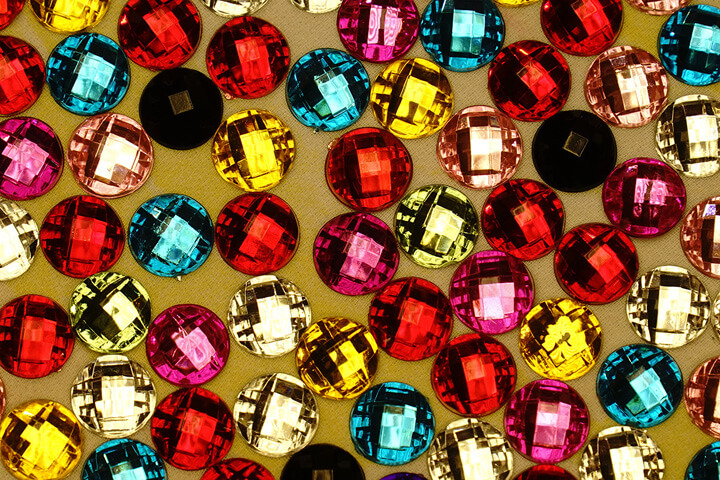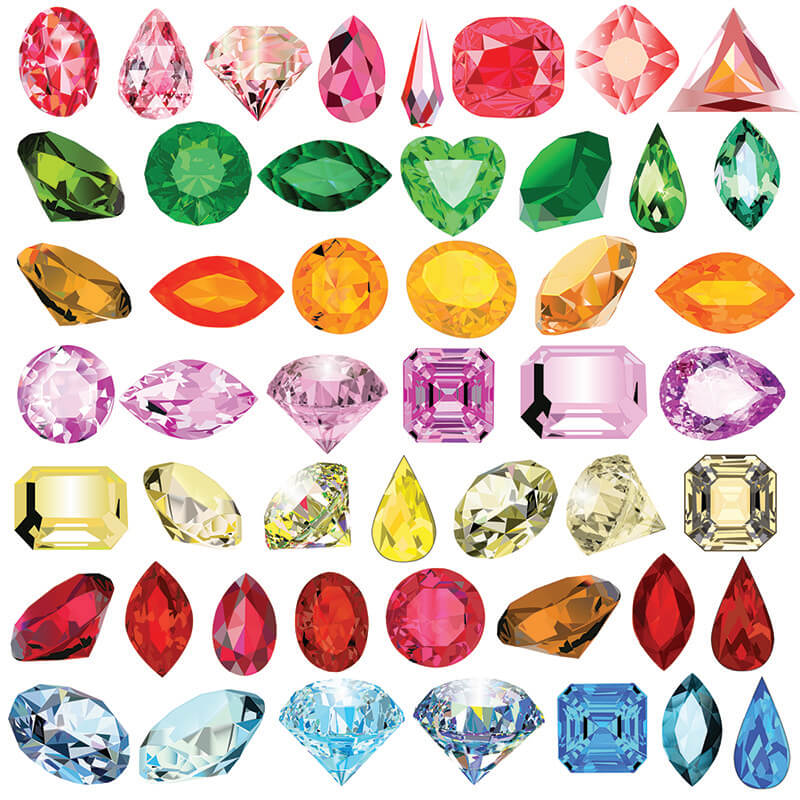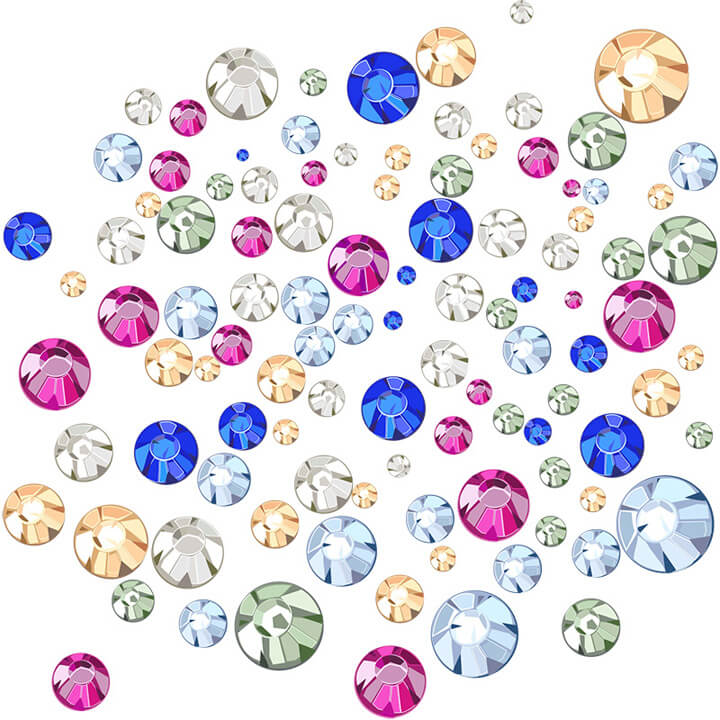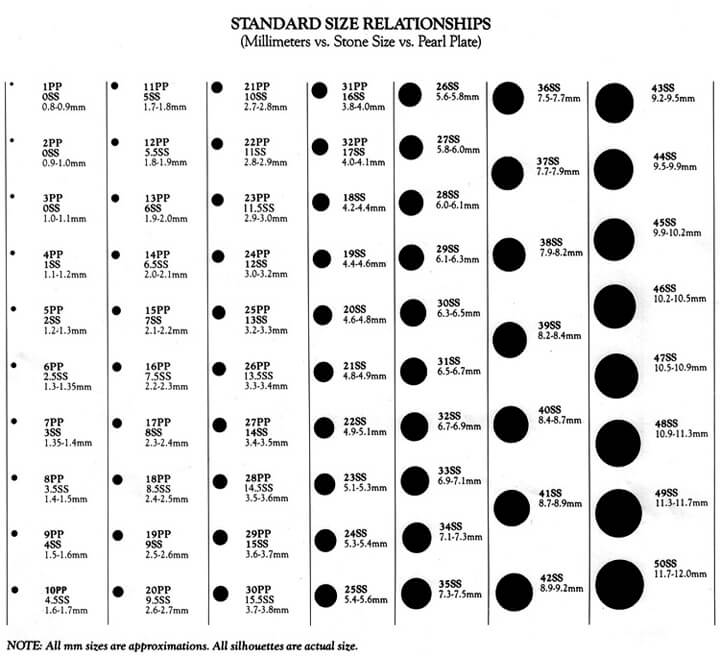
For hundreds of years, naturally occurring quartz crystals found along the Rhine River in Europe were coveted for jewelry but were eventually depleted from the area. This is when, in the 19th century, jewelers sought to create an imitation, aptly named rhinestones. Rhinestones are now made of crystal, glass, or even plastic.
The European Difference
Featuring 14 pristine facets, Austrian European crystal rhinestones are a cut above the rest. You’ll see precision cutting so that all of the facets line up at perfect points. The crystal will be free of bubbles and imperfections.
Cuts

- Machine Cut – Machine cut rhinestones have been crafted with crisp edges and polishing, creating an overall sparkling effect.
- Table Polished – The top facet of the rhinestone is called the “table”. The table is the only part of the stone that is polished and it has a less dazzling effect compared to machine cut rhinestones.
- Fire Polished – Lacking the sharp edges of machine cut stones, these stones are polished by heat, vibration, or a combination of both.
Styles
There are four basic styles of rhinestones that are available on the market.
- Roses – Roses are the most common type of rhinestone and are round and flat-backed. These can be attached with settings or glued directly to fabrics.
- Lochrosen – Typically seen in clothing, the lochrosen rhinestone is round and flat-backed but has a small hole in the center. With the help of a small bead, the stone is sewn in place. These do not have a foil back, which will impact its luster.
- Flat-backed sew-on – Similar to lochrosen, the flat-backed sew-on rhinestones have two holes at opposite ends—it’s important to stich both ends to properly secure the stone.
- Chatons – As opposed to a flat-backed stone, a chaton has a faceted, pointed back that reflects light better than the rose shape and resembles gemstones.
Backs
Another way to identify rhinestones is by the style of the backing.
- Flat-back – As the name suggests, this style has a flat back and can be attached to clothing or used in crafts.
- Faceted back – Instead of having a flat back, this style is faceted and pointy. Sometimes also called a chaton.
- Foiled back – The underside of the rhinestone is coated with a metallic foil that lends a mirrored effect, which helps reflect more light. This is one of the most popular types of rhinestones.
- Unfoiled back – There is no foil, giving this type of rhinestone the appearance of a gemstone.
- Domed back – As opposed to having a faceted or flat back, this has a rounded back.
Colors and Finishes

You may notice that many rhinestone colors are named for the gemstones they most closely represent. High quality rhinestones have a “pure” color, meaning the color does not vary within the stone.
Some rhinestones will also have different finishing effects, each of which produce a unique look. Effects may coat the surface or create a backing that essentially changes the base color.
- Aurora Borealis – The AB effect, as it is sometimes called, creates an iridescent effect on the stone’s base color. Many European crystals feature this beautiful rainbow effect.
- Satin – A satin coating gives the stone a soft sheen.
- Matte – Less common, but this finish dulls the base color.
- Comet Argent Light – Sometimes known as CAL, this finish has a bright silver finish that won’t tarnish.
- Vitrail – Featuring a silvery surface, the vitrail finish has flashes of pink for a unique look.
- Heliotrope – This finish is full of vibrant blues, purples, and greens.
- Tabac – Tabac rhinestones have a subtle coppery gold look that’s surprisingly warm.
- Aurum – Made with real gold, this finish is exceptionally bright.
Shapes
Rhinestones come in a wide variety of shapes that are perfect for jewelry or enhancing clothes and accessories. There are several common styles you will see in your search for exceptional rhinestones.
- Baguette – The baguette shape is elongated and rectangular. These look fantastic in channel settings but also generally have an appealing geometric shape that can make any jewelry a statement piece.
- Square – Another popular geometric shape, the square looks stately and is easy to identify.
- Round – Probably the most popular style of rhinestone is the round shape. That’s not to say that the surface is rounded but rather that the base is circular—you’ll still get lovely facets and a luminescent surface.
- Oval – Similar to a round shape, but slightly elongated.
- Marquise/Navette – Similar to the oval, the marquise and navette shapes are elongated and have pointed ends, but the navette is typically slimmer and longer.
- Teardrop/Pear – Rounded at one end and tapered to a point at the other, the teardrop shape is easy to identify.
- Triangle – Slightly less common but no less beautiful is the triangle shape. Occasionally, this is known as the trillion or trilliant cut.
- Novelty – Styles don’t stop at the basics. You may find novelty shapes such as flowers, hearts, and skulls.
Sizes

There are three methods for measuring the size of rhinestones, millimeters (mm), stone size (‘ss’), and pearl plate (‘pp’). Original sizing was based on the sizing technique for pearls, which were sifted through plates with graduated holes. Separately, jewelers developed a similar sizing system known as stone size. Check out our size chart for comparisons.
Settings
Identify styles of rhinestone jewelry based on their settings.
- Bezel Setting – The bezel setting requires the most craftsmanship and has a beautiful look when done successfully. A continuous metal band surrounds the stone and holds it in place at the edges.
- Channel Setting – As the name suggests, stones are set inside a metal channel for a linear design. Square cuts look particularly sleek with this setting.
- Hand Set – This is the result of an artist hand fixing each stone. You may see this type of settings with metal prongs holding the stones in place.
- Pave Set – In this unique setting, stones are placed so closely to one another that you cannot see the metal base.
When you’re first looking for rhinestones, it can feel overwhelming to choose the right ones, but with the help of this guide it should be easier to identify high-quality rhinestones for modern and vintage jewelry and clothes. Be sure to check out our huge selection for your next project!



